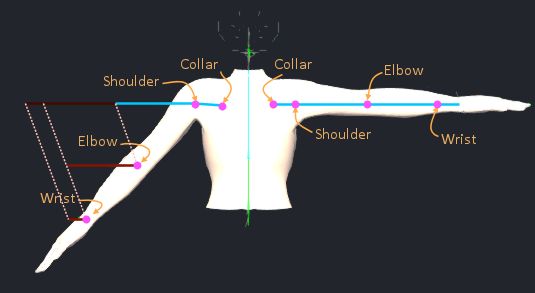

- SECOND LIFE BENTO SKELETON COLOR CHART HOW TO
- SECOND LIFE BENTO SKELETON COLOR CHART MANUAL
- SECOND LIFE BENTO SKELETON COLOR CHART SKIN
- SECOND LIFE BENTO SKELETON COLOR CHART FULL
- SECOND LIFE BENTO SKELETON COLOR CHART PLUS
If the copy-paste numbers are right, connecting them shouldn’t change much. After a bone chain is built, if connect = “true”, check the Connect boxes in bone settings. I found it worked better not to extrude bones, but to build each bone by the numbers, then assign the parent by consulting the spreadsheet. Repeat for the next bone in the hierarchy: mSpine1. Put it into Edit Mode, copy-paste the bone head values, 0.000000, 0.000000, 1.067015 and bone tail values 0.000000, 0.000000, 1.151015 from the spreadsheet into the bone settings (side panel or Transform in the Properties Editor, Bone Settings).

To build it in Blender from the numbers: First, make a bone. You can see the formulas in the spreadsheet.
SECOND LIFE BENTO SKELETON COLOR CHART PLUS
This column plus or minus that one, swap x and y, doink with it until it works.

Maya has a different system for defining the position, size and rotation of an armature bone in 3D space, and it takes a little arithmetic to convert the values to Blender’s bone head and bone tail system. “pos”, “rot” and “scale” are used for the collision bones. Then you’ll think “this is stupid easy.” Because it kind of is.Ī has coordinates for “end” and “pivot”, based on the original Maya-authored Second Life armature, where each mBone’s value adds or subtracts from its parent bone.
SECOND LIFE BENTO SKELETON COLOR CHART MANUAL
If you don’t, you’ll need to google the manual and forums until you get it. If you already know a lot about Blender and armatures, the rest of this blog should make sense. I am still not an expert, by any means, but I’m having fun with the bits I’ve managed to absorb, and you may too. I found the best recommendations for tutorials at Blender Artists. It’s like playing with Legos, except you’re making things that will move mesh. If you’ve never done this before, I recommend taking some animation courses and giving it a try. I sorted the xml data until I could make sense of it. It’s constantly updated, or will be until I’m happy with this project. ods, which I work on at the RuthAndRoth GitHub repository under Reference > Ada Radius. So I jammed the xml text into a spreadsheet, opensim_armatures. Spreadsheets are one way I make sense of information. Most of us with this can’t even tell left from right.
SECOND LIFE BENTO SKELETON COLOR CHART FULL
Full disclosure: I have directional dyslexia, very common in 3D artists. But I’m a retired CPA, opera singer, actor until I got too disabled to perform. One way to view the information is in NotePad++. The viewer looks at it, along with the collada rigged mesh upload data – the dae files – and other programming voudou, to calculate our avatars inworld. Some of them are out at the RuthAndRoth OSGrid sim.Īvatar_skeleton.xml is an interesting little file found in every viewer. I also made a bunch of simple prim models while I was figuring it out.
SECOND LIFE BENTO SKELETON COLOR CHART SKIN

159 bones now, in this teen aged armature. Armature bones for face, fingers, wings, tail and animal hind legs. In 2014 or so, artists began to make “fitted” mesh we could rig to the collision bones, to make attached clothing or an attached mesh body move with the Appearance sliders. Each collision bone is clamped to its mBone parent, so that a vertex weighted with PELVIS, (the collision bones are in CAPS), will move with its clamped parent, mPelvis.Ī few years later we got a few more bones for feet and skull. The Second Life armature, about fifteen years ago, consisted of 21 movement bones – “mBones” plus 26 collision bones, which at that time, besides keeping avatars from walking through each other, were used in the inworld Appearance sliders, to make the default avatar fatter or thinner, more muscular, and the ever-popular big boobs and butt. I think this information should have been made more public years ago. Along the way I floundered like a beached jellyfish and ran around the mulberry bush like a hound chasing imaginary rabbits.
SECOND LIFE BENTO SKELETON COLOR CHART HOW TO
It took a while for me to figure out how to find the information I needed. Licensed under Creative Commons Attribution-Share Alike 3.0. Copyright ©2003-2020 Linden Research, Inc. What we have to work with are three Second Life sources: avatar_skeleton.xml, male_2016_08_05.dae,, and. Then I’ll use what I learn to do the Default Bento Female for the next Ruth release. What I want is a replica of the Default Bento Male in Blender 2.8x, so I can use it to rig the next release of Roth, and get it exported from Blender 2.8x and into an opensimulator grid without tears. Now that I rather painfully figured out how collision bones export from Blender so that they almost work inworld, it’s time to tackle the mBones.


 0 kommentar(er)
0 kommentar(er)
